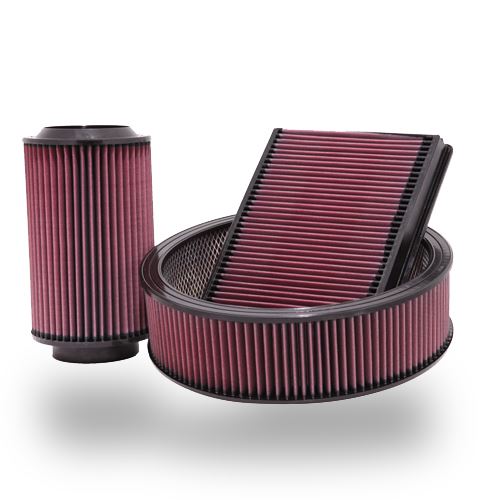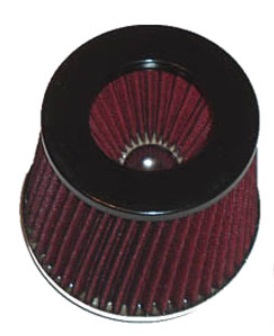Types of Air Filters for Cars
Types of Air Filters for Cars

The air intake is when the party begins for your internal combustion engine. The air intake starts with the air filter so knowing the types of air filters for cars is important. The more air you can intake, the more fuel you can combust, and the more power you can make. With that in mind, it’s no surprise most car enthusiasts start with upgrading the incoming airflow as their first modification. If you don’t want to yet splurge on car mods or an upgraded intake, an upgraded air filter may fit the bill. But, there are different types. Here we’ll discuss the different types of filters to help determine which may be the best for your modification path.
Before getting into the different types of filters, let’s first understand the air filter’s purpose. As the name implies, it filters the incoming air to your engine. This is incredibly important to the engine’s operations. Having a dirty filter can restrict incoming airflow and, in turn, restrict performance. In addition, if your filter has failed, it can allow in large contaminants that can potentially cause catastrophic engine failure. This is exactly why the air filter is so important. But, there are different characteristics to consider with your air filter. We’ll consider the material, shape, and whether the filter is oiled versus dry.
Material
There are different materials from which your engine’s air filter can be made. The most common materials you’ll find are paper, foam, and cotton.
Paper
The paper air filter is among the most common and what most vehicles come with as original equipment. While these do a fine job of filtering contaminants, they can restrict airflow. Paper filters are often the least expensive but are typically not able to be cleaned and reused. If you plan on keeping your vehicle for at least a few ten thousand miles, it may be better to shell out the initial higher cost of a reusable filter which will save money in the long run.
Foam
A foam filter is another option. However, this is typically reserved for small engines who’s duty is to an appliance. This is because it filters well in particularly dusty environments but does have significantly more restriction on airflow relative to the other types. These last longer than a paper filter and can be reused in some cases. If performance isn’t a concern, the foam filter may be the way to go.
Cotton
A cotton filter is a go-to material for most aftermarket filters. This is because this material has effective filtration but also allows the most airflow. Additional filtration properties can be had if the filter is oiled (more on that later). The cotton filter is usually held within a metal framework to hold its shape which can vary greatly.
Shape
There are several shapes your air filter can take on. The shape of the filter can have a significant affect on the amount of air intake potential and in turn performance. The two most common types of shapes an air filter comes in are a panel and cone shape.
Panel
Most factory air boxes will use a panel filter. A panel filter is a flat plane. Upgrading your panel filter from the factory paper element to a cotton filter element can be beneficial but changing the filter or intake altogether can yield an even better result.
The greater the surface area of the filter, the more air that can be taken in. This is why most filters have pleats or ridges; to increase surface area. Expanding on that principle, most aftermarket filters have these pleats in a cone shape to further increase the surface area over a flat panel.
Cone
A cone shape offers a significant gain in terms of surface area when trying to funnel air into a tube. Although you could have a massive panel with the same surface area, the cone shape allows more uniform velocity funneling to the intake tube throughout the filter. To further this idea, some filters have an inverted cone within the center of the cone shape (shown below) to add even more surface area.

Oiled vs Dry
Dry Filter
Most OEM filters come in the dry variety. These are typically panel shaped filters that are a paper or foam material. As mentioned before, these do a great job of filtering our contaminants from your engine’s intake, but they are fairly restrictive. Once a layer of dirt is added, the restriction becomes even more of a hindrance to performance.
Dry filters will require less maintenance but that’s really because they’re not typically reusable since cleaning them would damage the paper material. In a pinch, you may be able to improve the life of a dry filter by blasting it with some compressed air. However, this can only be done so many times. If you’re in particularly dusty conditions (especially racing in sand), the dry filter may be advantageous as it won’t need constant cleaning. For most drivers, the oiled filer will provide the upper hand in filter needs.
Oiled Filter
Most upgraded intakes include an oiled filter made of cotton material. This is because the oiled filter will typically allow more airflow and the cotton material is more durable to cleaning than paper. This increased airflow is mostly realized through larger micron holes. But wait! Won’t larger holes in the filter allow for more contaminants into the engine?! While this is technically true, the difference is typically within 1%. The oil on the filter provides a barrier that allows air to flow through but will catch contaminants before they get through the medium.
Some folks might argue that oiled filters can potentially damage your engine or cause the car to run improperly. Let’s clarify concerns.
Oiled Filter Concerns
Any differences in the filter element, changes in tubing bends, or different diameter piping can change how air passes over the MAF sensor. This can cause an unintended voltage reading to the ECU resulting in an improper amount of fuel being injected. If any of these changes are present, the MAF sensor must be properly re-calibrated to “see” those changes. If you run an intake for which the mapping is not properly designed, the car could potentially run dangerously lean(or rich) and stumble throughout the rev range. Luckily, COBB has you covered with Off The Shelf maps which are designed to work with upgraded intakes. Now that we’ve covered what can potentially make the car run improperly, let’s talk about potential engine damage.
The concern over engine damage with an oiled filter can only happen if the MAF sensor becomes damaged from oil. This is a way overstated concerned as this can only occur with SEVERE over-oiling. As long as you’re not overly generous (don’t submerge the filter in oil), this will not happen. The filter shouldn’t have so much oil that it comes off. You can gauge the appropriate amount of oil on the filter when you first receive it.
All COBB filters will come pre-oiled so you don’t have to worry about any setup initially. Cleaning your upgraded filter is a breeze with the COBB air filter cleaning kit.
Which Filter to Choose
When choosing the right intake air filter for your application, it really comes down to your personal needs. The most important considerations are the conditions you’re driving in along with whether or not you’re up for a little maintenance. If maximum performance piques your interest, the oiled filter is the way to go in whichever shape you can get. If you’re racing off-road or just don’t like the thought of maintenance, a performance dry filter may better fit the bill.
Now that you’ve got the gist of the air filter, be sure to check out the Difference Between Cold Air Intake vs Short Ram Intake, Cold Air Intake Pros and Cons, and How to Get More Out of Your Air Intake System on Turbo Cars: Upgraded Turbo Inlet Hoses!

What is the model/size/sku for the air filter that comes with the 15+ Wrx Big SF intake?
Hi Nathan,
Here is a direct link to the filter you need: https://www.cobbtuning.com/products/air-induction/subaru-wrx-ford-mustang-ecoboost-intake-replacement-filter
Kyle@COBB
Hi what air filter is suitable for dusty conditions? i live in rural nsw.
I Own 2016 wrx sti. Currently has a Cobb air filter
Hey Angie, a dry media filter would be ideal for extreme dusty conditions. We currently only offer an oiled filter but you may be able to find an off-the-shelf filter at your local parts store or online that will work with our intake.
Marshall@COBB